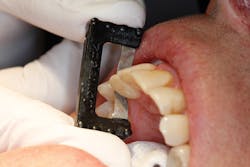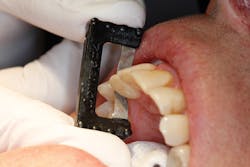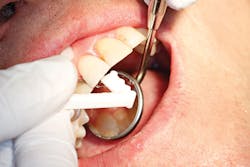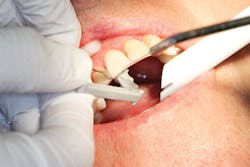Adjust-Clean-Polish: A simple 3-step technique for perfect crown seating
Daniel S. Kim, DDS, FAGD
Any athlete can tell you how important it is to give 100% of your effort from start to finish. After all, few races are won by runners who slow to a relaxed walk just before the finish line, and baseball players cannot just call it a day after playing well for six innings.
This same idea is just as critical for us as dental practitioners. For us, the final steps of many procedures are integral to the long-term health and viability of the work we have done for our patients. This has a direct effect on the health and viability of our practices; patients rarely recommend or return to dentists who have provided them with short-lived restorations.
This is, perhaps, most readily seen when seating crowns. Even a perfectly made crown can fail within two years if it is not seated properly. In developing ContacEZ, and through my own clinical research and the feedback of my colleagues, I have established a system of three key steps that should be taken during the interproximal finishing of every crown: adjusting the proximal contact, removing trapped cement debris, and polishing to remove surface roughness.
Proximal contact adjustment
Although rarely covered in the literature or in dental school curricula, proximal contact adjustment is important to seating crowns successfully. Leaving proximal contacts unadjusted when seating a crown can be catastrophic for the restoration and for the patient's oral health. The pressure the crown creates can cause a wide variety of complications, and seating the crown completely might be impossible, leaving open margins exposed to bacterial accumulation.
For patients, the constant feeling of pressure from tight contacts on a newly crowned tooth is more than physically uncomfortable. For many, it is also a reminder that the crown is synthetic. Taken together, these issues lead to dissatisfaction with the procedure and, possibly, its provider.
Snapping dental floss through the contacts has long been used to check the strength of proximal contacts, but twisting and warping often make this inaccurate. Instead, I recommend using a single-handed diamond strip to adjust contacts directly in the mouth (figure 1). The material strength of the stainless steel strips improves consistency, and adjustments can be performed in the mouth to ensure comfortable and complete marginal seating with every patient.
Figure 1: A single-handed diamond strip is used to adjust proximal contacts directly in the mouth.
Cleaning out trapped resin cement
Unlike proximal contact adjustment, the need to remove excess cement is widely known. Here, the problem is not a lack of attention to the necessity of the task but the challenging nature of the task.
Passing knotted floss back and forth through the contact to gradually pull out scraps of trapped cement is ineffective and tedious for practitioners and uncomfortable for patients. Moreover, the lack of tactile control and finesse inherent in using floss can easily leave some remnants in areas that are hard to see or reach.
Again, I have found that a single-handed, stainless steel strip outperforms floss on nearly every metric. For interproximal resin cement removal, a thin, serrated strip shares much of the desirable flexibility of floss, but it drastically improves on both ease of use and efficiency (figure 2).
Figure 2: A single-handed, thin, serrated strip is used to remove resin cement interproximally.
Final polishing
Polishing the restoration is, unfortunately, the most commonly skipped part of the system. This step suffers for being the last piece of a large, time-consuming puzzle. It can be tempting to save chair time and skip a task that seems trivial after all that came before it.
Research on this subject is clear. Rough surfaces on teeth, especially on restorative materials, facilitate biofilm formation. Increased surface roughness allows bacteria to more easily adhere to subgingival and supragingival surfaces, increasing the threat of periodontitis or peri-implantitis in susceptible individuals.
Here, the key is in balancing efficacy and convenience. A single-handed finishing strip has been my solution of choice; they are easy to control and make short work of polishing out stubborn diamond marks (figure 3). Be sure to get the finest abrasive possible, though, to ensure you confirm interproximal relief without reopening the contact.
Figure 3: A single-handed finishing strip is used to polish stubborn diamond marks.
Conclusion
In my work with ContacEZ, I have had the opportunity to hear from thousands of dentists all over the world. The Adjust-Clean-Polish system is a product of our combined experiences, created to address common issues and frustrations with the complete marginal seating of crowns and other restorations.
By using these three steps as a set system of necessary technique, undertaken with every crown procedure, we can better organize and simplify our mental workloads and form routines that ensure our patients receive only the highest standard of dental care. The Adjust-Clean-Polish technique minimizes the risks of a wide array of partially or wholly iatrogenic conditions and thereby safeguards our patients' good faith in us and our practices' reputations.
Let's all be like the runner who finishes the race at a sprint-take "Adjust-Clean-Polish" as your mantra when finishing every crown.
Daniel S. Kim, DDS, FAGD, is in private practice in Vancouver, Washington. He lectures in dental scientific sessions, seminars, and study clubs. He is a past part-time faculty member at Yonsei University Dental School and visiting professor at Korea University Medical School in South Korea. He can be reached via e-mail at [email protected].



